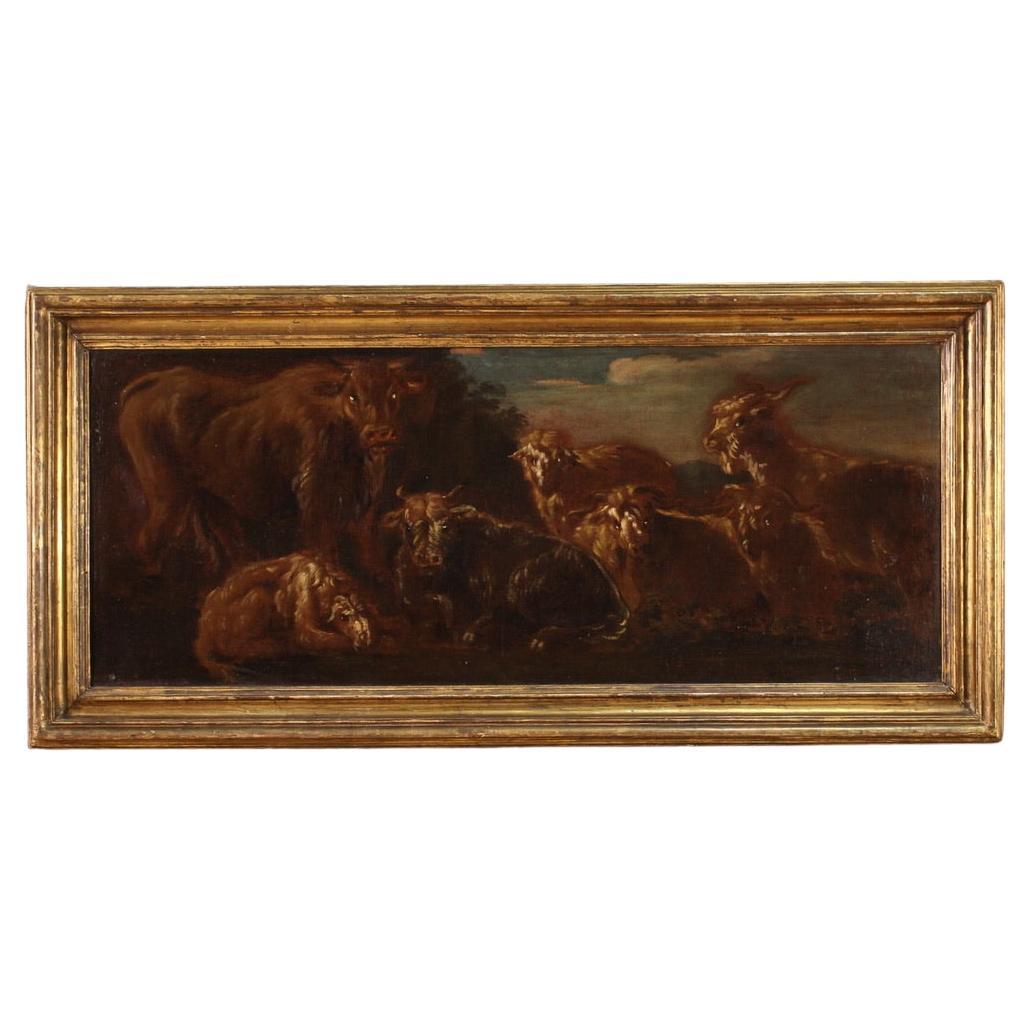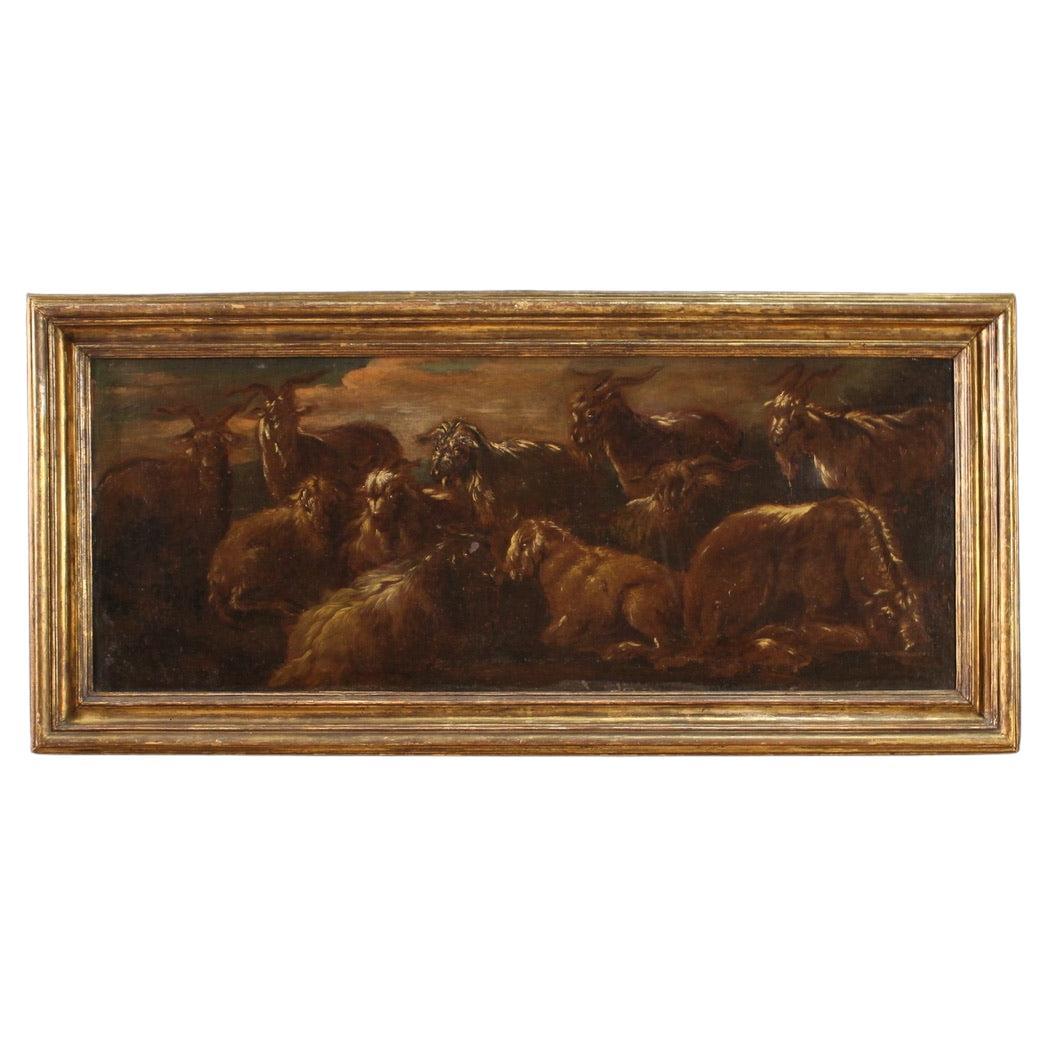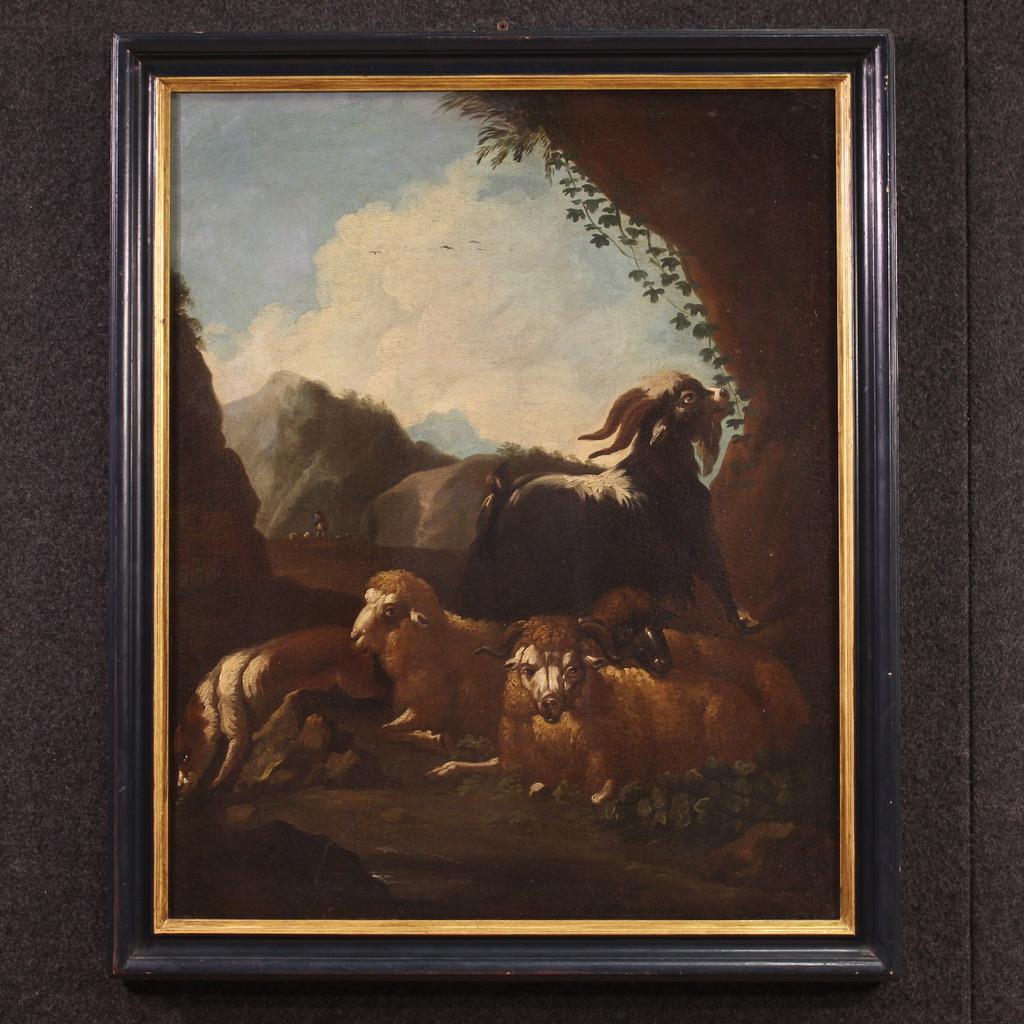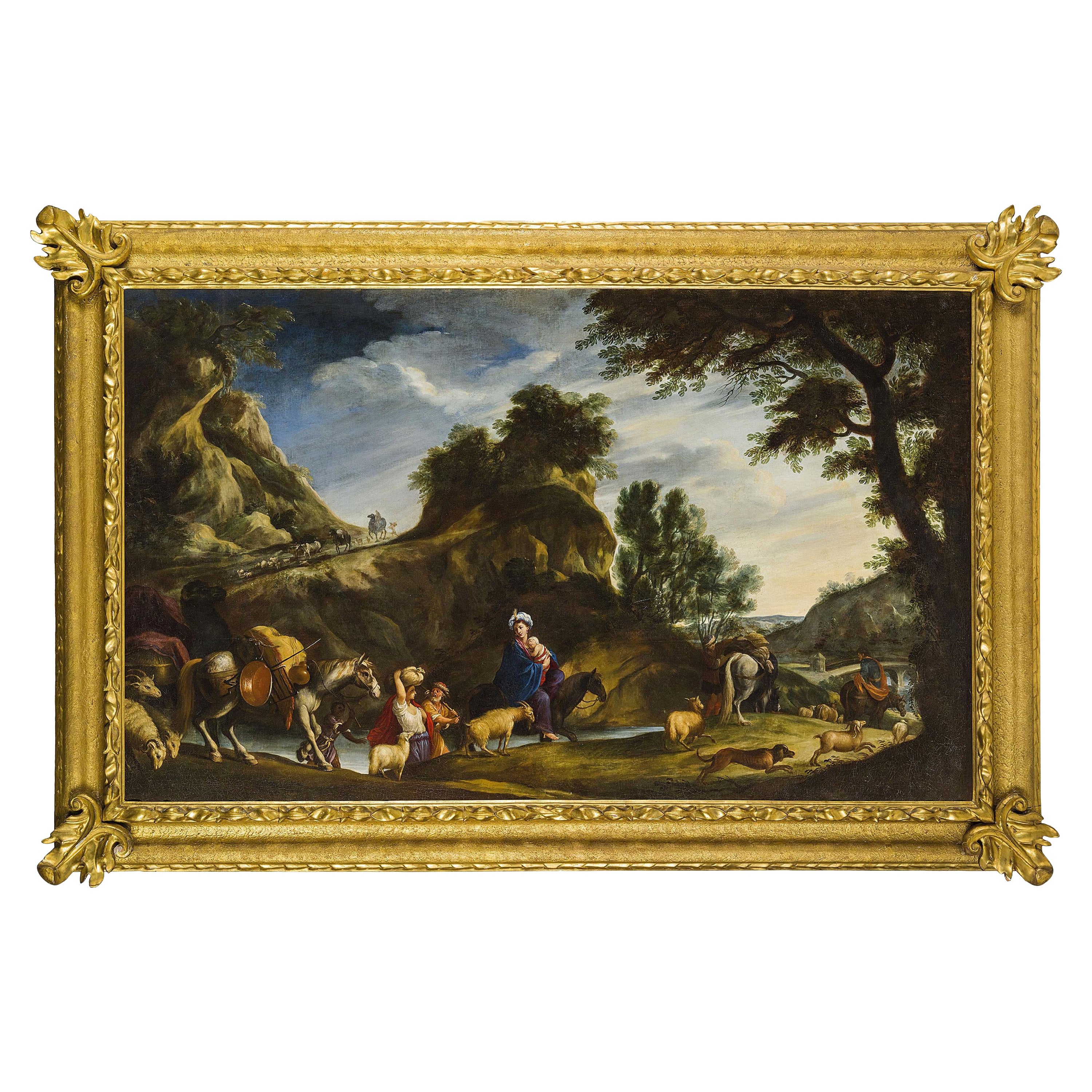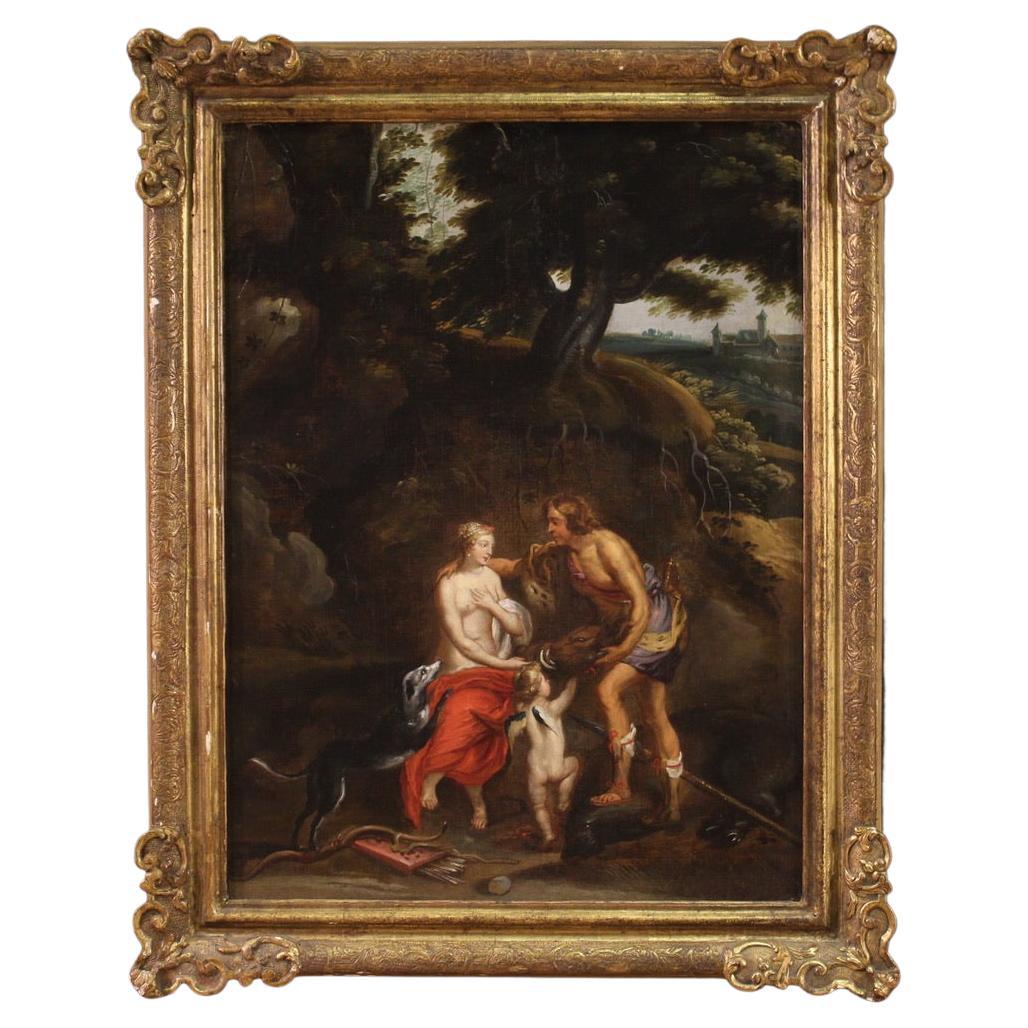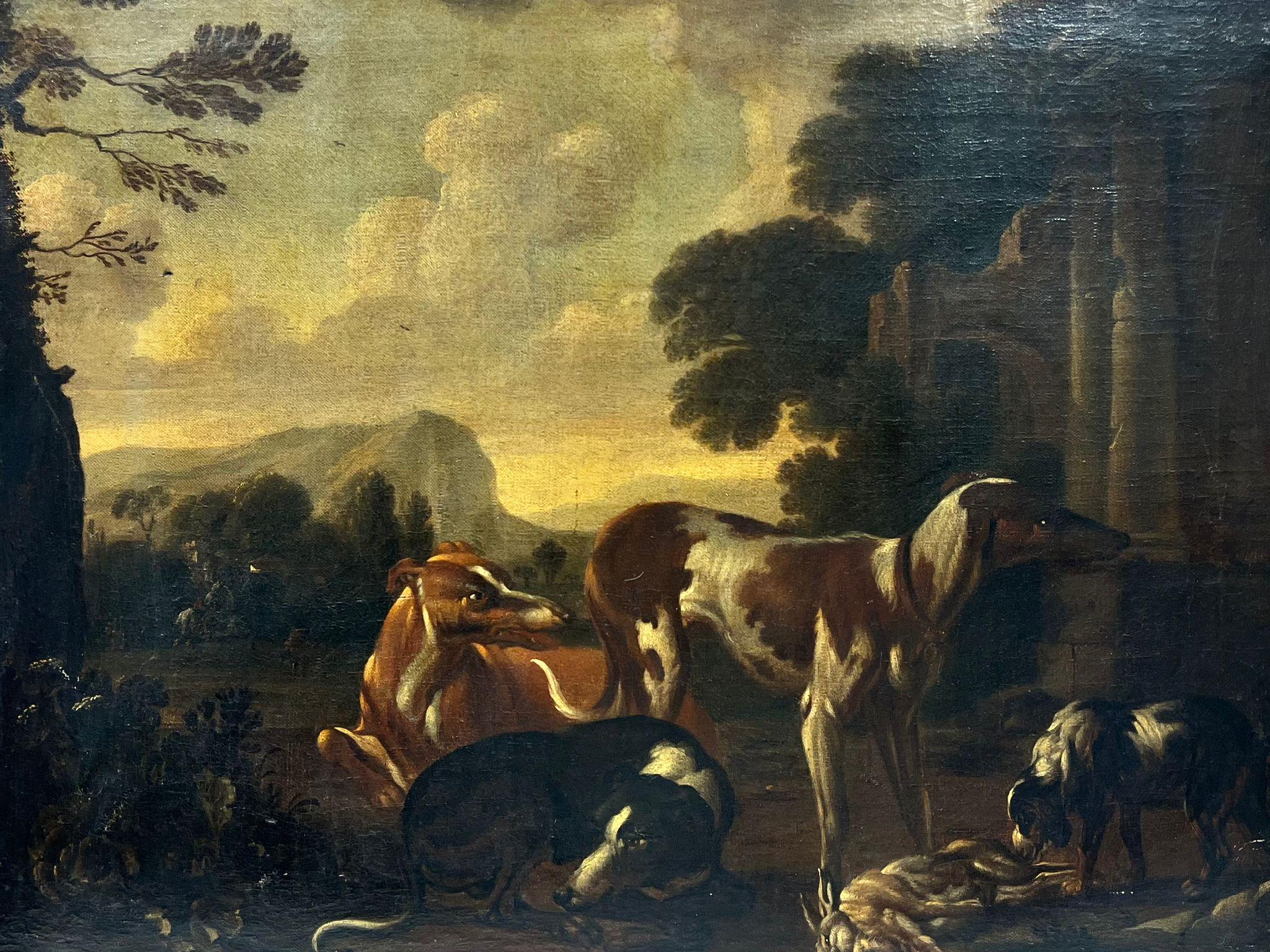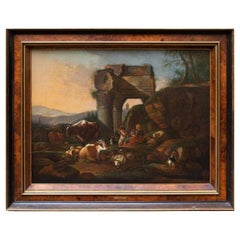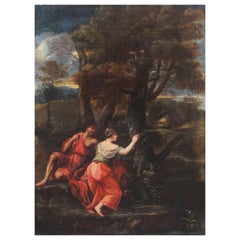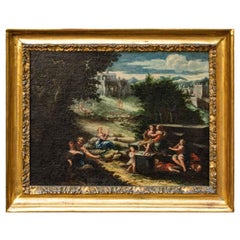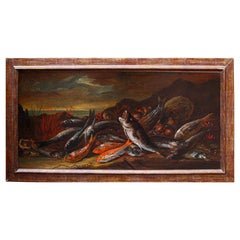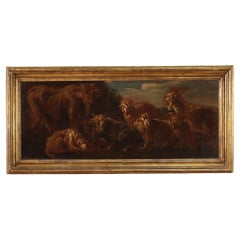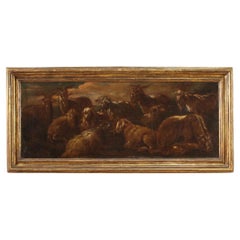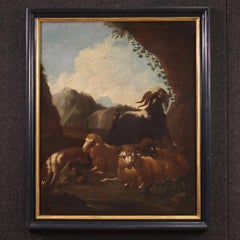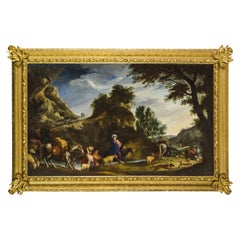Items Similar to 16th Century Animals Painting Oil on Canvas by Crivellino
Want more images or videos?
Request additional images or videos from the seller
1 of 10
16th Century Animals Painting Oil on Canvas by Crivellino
$8,144.63
£6,035.62
€6,800
CA$11,118.97
A$12,369.40
CHF 6,484.19
MX$151,151.01
NOK 82,568.11
SEK 77,726.45
DKK 51,774.60
Shipping
Retrieving quote...The 1stDibs Promise:
Authenticity Guarantee,
Money-Back Guarantee,
24-Hour Cancellation
About the Item
Giovanni Crivelli known as Crivellino (Milan,? - Parma, 1760) Fight between dogs and bison
Oil on canvas, 84 x 111 cm
With frame 112 x 139 cm
Thanks to the comparison with his autograph works, which will be mentioned, the present painting can be traced back to the hand of the Milanese Giovanni Crivelli (Milan,? - Parma, 1760) called Crivellino to distinguish him from his father Angelo Maria, also a painter and known as il Crivellone (news from 1662 - 1730 ca.).
The confirmation of Crivellino's paternity comes mainly on the basis of a comparison with some paintings in the Cova Minotti collection in Milan, depicting a wild boar attacked by dogs (signed and dated “Gio. Crivelli fec.1720”) and a bear attacked by dogs. Strict similarities are visible in the setting of the work, in the composition and in the re-proposition of the same types of dogs and bison, in particular in another work of the same collection depicting an Assault on the bison.
These works testify in Crivellino's corpus to the reference to international hunting culture, in particular to the Flemish one, almost with the intention - as Arisi points out in the aforementioned monograph dedicated to the two Crivellis - to compete with those models. Canvases much appreciated by contemporaries and by the great aristocracy; Lanzi recalls Crivellino, among other things, who was very active at the Farnese court in Parma.
The canvas in question depicts a fight between dogs and a bull in which the expressive power and strength that Crivellino's painting can achieve are fully manifested. The three dogs, caught in different poses, growling, with their mouths open seem to surround the bull in distress. The brushstroke is fast, yet defined, and vibrates, transmitting further excitement to the dynamism inherent in the scene. The rendering of the coats, of great quality, seems alive, making the idea of ??animal hair real. The bull, in difficulty, seems to turn its head ready to collapse to the ground. The dimensions of the fighting animals dominate the surrounding landscape, focusing attention on the fight, even if the architectural ruins and the distant sky fade are of great charm.
- Dimensions:Height: 44.1 in (112 cm)Width: 54.73 in (139 cm)Depth: 2.37 in (6 cm)
- Materials and Techniques:Canvas,Oiled
- Place of Origin:
- Period:
- Date of Manufacture:16th Century
- Condition:Refinished. Wear consistent with age and use. The painting has been cleaned.
- Seller Location:Milan, IT
- Reference Number:1stDibs: LU5918226766582
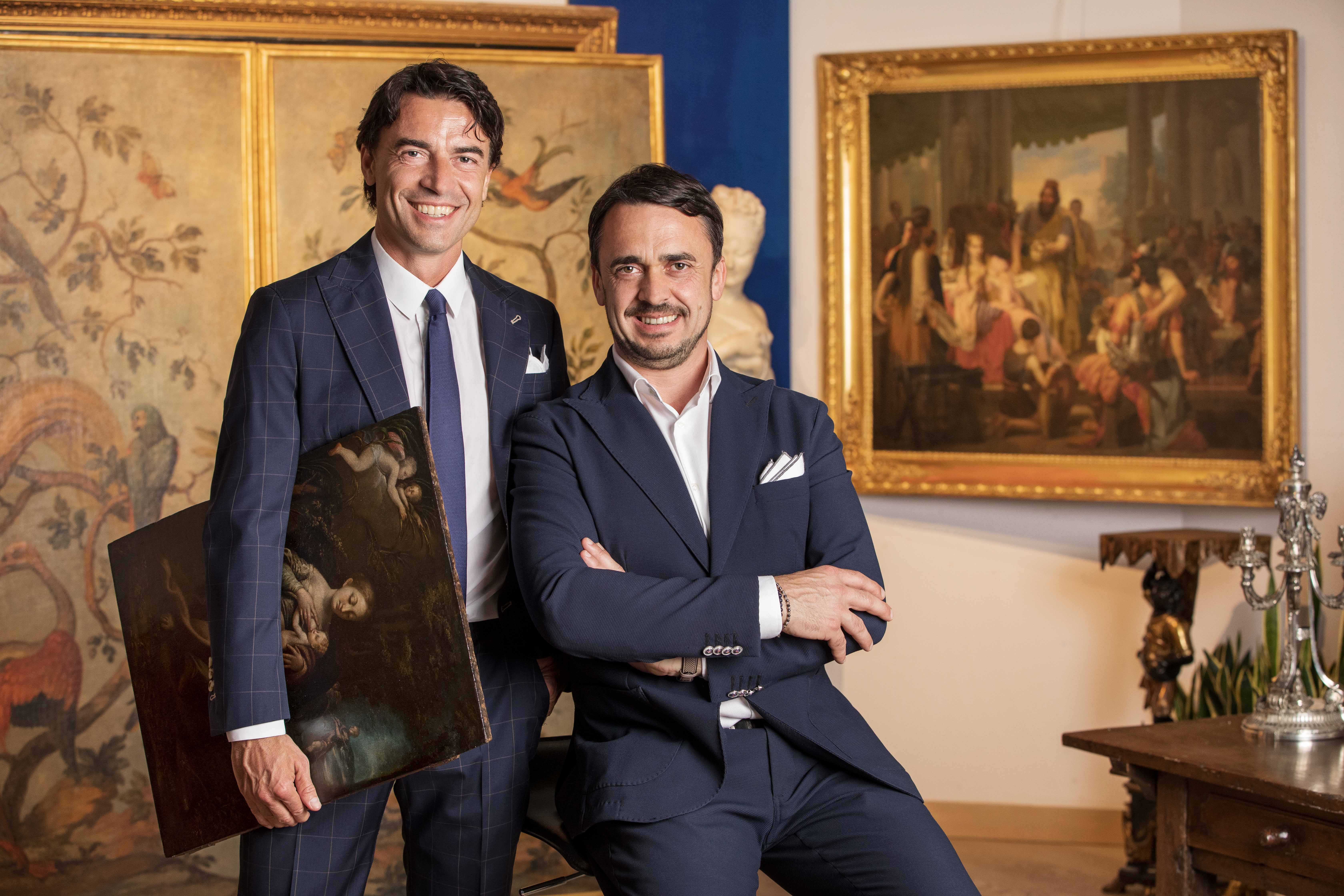
About the Seller
5.0
Vetted Professional Seller
Every seller passes strict standards for authenticity and reliability
Established in 2000
1stDibs seller since 2021
30 sales on 1stDibs
- ShippingRetrieving quote...Shipping from: Milan, Italy
- Return Policy
Authenticity Guarantee
In the unlikely event there’s an issue with an item’s authenticity, contact us within 1 year for a full refund. DetailsMoney-Back Guarantee
If your item is not as described, is damaged in transit, or does not arrive, contact us within 7 days for a full refund. Details24-Hour Cancellation
You have a 24-hour grace period in which to reconsider your purchase, with no questions asked.Vetted Professional Sellers
Our world-class sellers must adhere to strict standards for service and quality, maintaining the integrity of our listings.Price-Match Guarantee
If you find that a seller listed the same item for a lower price elsewhere, we’ll match it.Trusted Global Delivery
Our best-in-class carrier network provides specialized shipping options worldwide, including custom delivery.More From This Seller
View All17th Century Architectural Capriccio with Herds Painting Oil on Canvas
Located in Milan, IT
Circle of Nicolaes Berchem (1620, Haarlem - 1683, Amsterdam)
Architectural capriccio with herds
Oil on canvas, 57.5 x 74 cm
With frame 76 x 93 cm
The examined canvas is...
Category
Antique 17th Century Dutch Paintings
Materials
Canvas
17th Century Angelica and Medoro Painted Oil on Canvas Roman School
Located in Milan, IT
Roman School, 17th century
Angelica and Medoro engrave their names on the bark of a tree
Oil on canvas, 65 x 48.5 cm
The canvas depicts one of the most famous episodes of O...
Category
Antique 17th Century Italian Paintings
Materials
Canvas
17th Century Rural Landscape with Gallant Scenes Painting Oil on Canvas
Located in Milan, IT
17th century, Emilian school
Rural landscape with gallant scenes
Oil on canvas, 37 x 47.5 cm
With frame 61 x 50.5 cm
The bucolic amenity of the present is reflected in the joyful gallant scenes that dot its surface. The locus amoenus described reflects on the more traditional inflection of Arcadia, which in the literary transfiguration was the scenario par excellence of the most carefree pastoral life and out of this world; the painting is therefore a forerunner of what was professed by the actual poetic academy of Arcadia which was established in Rome in 1690, but enthusiastically testifies to the feverish invitations to its acceptance, then widespread in the most avant-garde cultural salons throughout Italy. First Theocritus and Virgil later had awakened with Idilli and Bucoliche that capacity typical of the natural world to allow an escape from reality; the contemplation of perfect natural fruits that followed would have evoked in the spirits of dreaming men back to origins. The bucolic landscape was able to positively give a rhythm to material life, and constituted the concretization of a place devoid of incivility and ugliness, where only dreams, wild music and homages to fruitful nature were allowed.
In the present painting widespread figures of shepherd children trace the same intent to the sublimation of earthly life, gathered in pairs, while children on the model of the ancient cherubs cheer the field with flowers and petals. The games of these and the sweet affections of the other characters are rendered through liquid and vibrant brushstrokes, flickering with a white light that opposes the dark shadow of the undergrowth. In the distance, the sky tapers with a silvery and flat brushstroke, while the vertical development of the promoters with architectures helps to introject a bright beam of light into the grassy clearing. The foliage and the turf of the landscape piece are rendered through a digital brushstroke, betraying the Italian brand of the present, influenced at the same time by the seventeenth-century European influences that then conveyed to the capital. The evocative culture of the city attracted many artists from the city of Bologna, from the Italian north but also from the territories beyond the Alps, such as Claude Lorrain and Nicolas Poussin. The historical-artistic heritage of the Italian pastoral scenes was thus able to fill up with the more functional and particular formalisms of the charms coming from elsewhere, such as the expressive tremor of the present, similar to the contemporary French lexicon.
The typological restitution from pastoral idyll, in accordance with the intrinsic stylistic qualities of the work, allows us to specify the solid belonging of the present to the Italian hand, similarly to what was then emerging in the pictorial sphere within the Emilian school. In this regard, we should recall the latent influences of two decisive foreign landscape painters who passed through the Emilian belt, such as Claude Lorrain (1600-1682) and Nicolas Poussin (1594-1665); before them, Giovanni Battista Viola...
Category
Antique 17th Century Italian Paintings
Materials
Canvas
17th century, recco follower, (Naples, 1634- Alicante, 1695), Still Life
By Chiaia and Napolitano
Located in Milan, IT
17th century, follower of Giuseppe Recco (Naples,1634- Alicante,1695)
Still life of fish, squid, oysters and corals on the beach
Oil on canvas, 57.5 x 117 cm
Framed, cm
On the b...
Category
Antique 17th Century Italian Other Paintings
Materials
Canvas
17th Century Live Nature Pair of Paintings Oil on Canvas Flemish School
Located in Milan, IT
Flemish School, 17th century
Live nature couple with animals
Measures: Oil on canvas, cm 25 x 35 - With frame cm 37 x 48
The pair of canvases in question depicts two excited...
Category
Antique 17th Century Paintings
Materials
Canvas
Oil painting on canvas depicting Still life Roman school of the 17th century
Located in Milan, IT
Roman School, 17th century
Still Life
Oil on canvas, 79 x 107 cm
Framed, 93 x 121 cm
The work under scrutiny, depicting a majestic still life of flowers, is ascribed to the 17th...
Category
Antique 17th Century Paintings
Materials
Canvas
You May Also Like
17th Century Oil on Canvas Italian Landscape with Animals Painting, 1680
Located in Vicoforte, Piedmont
Antique Italian painting from the second half of the 17th century. Artwork oil on canvas depicting a particular subject Grazing animals of good pictorial quality in the style of Rosa...
Category
Antique 1680s Italian Paintings
Materials
Canvas
17th Century Oil on Canvas Italian Landscape with Goats Painting, 1680
Located in Vicoforte, Piedmont
Antique Italian painting from the second half of the 17th century. Painting oil on canvas depicting a particular subject Grazing animals of good pictorial quality in the style of Ros...
Category
Antique 1680s Italian Paintings
Materials
Canvas
17th Century Oil on Canvas Bucolic Landscape with Animals Painting, 1680
By Philipp Peter Roos (Rosa di Tivoli)
Located in Vicoforte, IT
Elegant painting from the second half of the 17th century. Oil on canvas artwork depicting a splendid landscape with grazing animals, of great pictorial quality. In the foreground we...
Category
1680s Landscape Paintings
Materials
Canvas, Oil
17th Century, Italian Painting by Pier Francesco Cittadini, Jacob and his Family
Located in IT
Pier Francesco Cittadini (Milan, 1616-Bologna, 1681)
"Jacob and his family go to Egypt"
Oil on canvas, cm 109 x 190 (canvas only)
The valuable painting, made in oil on canvas, depicts Jacob and his family go to Egypt and we believe it can be, given the high quality painting, autograph work of Italian Pier Francesco Cittadini (Italy Milan, 1616 - Bologna, 1681) made after 1647. The work, in excellent condition is accompanied by a coeval frame in wood finely carved and golden.
The scene depicted, which was confused with the Flight to Egypt in the past years, is instead identified with the biblical episode of Jacob’s journey. In the foreground, reading the painting from left to right, we see a caravan composed of animals, including donkeys, dromedaries, goats, dogs and horses and people, women, men and slaves, who carry on their journey along the banks of a river, following a path that to the right, would seem to lead to the through of a bridge. In addition to the watercourse is described an environment characterized by large rocks and impervious come far to cover the entire verticality of the canvas. On the left, in the distance, we see the tail of the caravan that runs along the steep path. Large trees enliven and harmonize the environment, as well as white and grey clouds characterize the predominantly clear sky and illuminated on the right by sunlight.
The story is told in the Bible, Book of Genesis, 30, 25, passage in which is described the flight of Jacob from Haran after the contrasts with Laban, father of his wife Rachel. Jacob is the third great patriarch of the Bible. From his descendants originate the twelve generations of the people of Israel. He is the son of Isaac and Rebekah, who led him to flee from the wrath of Esau to Haran to seek refuge from his brother, Laban. At his uncle’s house Jacob met his daughter Rachel. As soon as he saw his cousin, Jacob was taken. Jacob will stay seven years in the service of Laban to marry his beloved Rachel. But Laban, with a deception, will give him in marriage first Lia, the least beautiful eldest daughter, and only after another seven years the splendid Rachel. From his first wife he will have several children, while Rachel will give birth to the beloved son, Joseph, who will become viceroy of Egypt.
After years of service, Jacob asked to be paid with every dark-coloured garment among the sheep and every spotted and dotted garment among the goats. Laban accepted and sent away from his sons all the leaders of that kind. So Jacob took fresh branches of poplar, almond and plane tree, and flayed them, and put them in the troughs. The optical suggestion induced the goats and the sheep to conceive and give birth to dark, striped and dotted garments. He also ensured that all the strongest and healthiest leaders of the flock of Laban would drink near the barked branches, thus assuring a genetic superiority to his part of the flock. His flocks grew numerous and strong and he became richer than his relative, arousing envy. It was clear that Laban would not respect him much longer. At the suggestion of the Lord, Jacob decided to return to Canaan. Trying to avoid any possible dispute, he left with his family while Laban was absent for shearing sheep. But when, three days later, his uncle returned home, he became angry, feeling offended because Jacob had gone secretly and had not allowed him to greet his daughters and grandchildren. In addition, his teraphim, statuettes, or idols, which depicted the family deities, had disappeared. After 7 days of pursuit, Laban and his men reached Jacob’s group on Mount Gilead, in the mountainous region west of the Euphrates River, where his uncle and grandson had a stormy conversation. The younger man was outraged at being accused of stealing idols and told Labano to rummage through his family’s tents at will. Neither of them could know or even imagine that it was Rachel who took the idols and hid them in the saddle of the camel. During the search, she sat down firmly on the saddle, apologizing for not being able to get up, «because I usually have what happens to women» (Gen 31:35). So the loot wasn’t discovered.
The author of this work was inspired by the composition of an engraving by Stefano Della Bella (1610-1664) of circa 1647. The engraving by Stefano della Bella bears the title "Iacob sur ses vieux jours quitte sans fascherie pour voir son filz Ioseph, sa terre et sa patrie" and is signed on the bottom left "Stef. of the Beautiful In. et fe." while on the right it is declared "Cum privil. Regis", that is with license of the king.
Stefano Della Bella (Italy - Florence, May 18, 1610-Florence, July 12, 1664) was born in a family of painters, sculptors and goldsmiths and was left early orphan of his father sculptor, he dedicated himself first to the art of goldsmith at the school of Giovanni Benedetto Castiglione and Gasparo Mola, then turning his attention to drawing and engraving. He soon began drawing figures and copying the etchings of Jacques Callot, which inspired his early works. Under the protection of the Medici, in particular of Don Lorenzo, cadet son of Grand Duke Ferdinand I, Della Bella has the opportunity to make study trips to Rome, where he stayed from 1633-1636; In Rome he met French engravers and publishers of prints such as Israël Henriet and François Langlois, who influenced his decision to move to Paris in 1639, four years after the death of Callot. In Paris he soon reached, thanks to the engravings commissioned by Cardinal Richelieu, the success also worldly; he frequented courtiers, theatre artists and writers, while refusing too oppressive honors. In 1646-1647 he continued his travels in the Netherlands to Amsterdam, Antwerp and Dordrecht. He returned to Florence in 1650 and resumed working under the protection of the Medici court, working for his patrons. In 1656 he became a member of the Academy of Apatists.
The painting object of this study is reasonably attributable to Pier Francesco Cittadini, or Pierfrancesco Cittadini, called the Milanese or the Franceschino (Italy - Milan, 1616-Bologna, 1681) as some exemplary stylistic comparisons proposed to follow can prove.
Pier Francesco Cittadini was an Italian baroque painter, mainly active in Bologna.
His artistic training first took place with the painter Daniele Crespi...
Category
Antique Mid-17th Century European Baroque Paintings
Materials
Canvas, Giltwood
17th Century Oil on Canvas Flemish Mythological Antique Painting, 1660
Located in Vicoforte, Piedmont
A splendid 17th century Flemish painting. Oil on canvas artwork depicting a mythological subject of great charm, Meleager offers the boar's head to Atalanta. The Fates had predicted ...
Category
Antique 1660s Dutch Paintings
Materials
Canvas
$8,623 Sale Price
20% Off
Free Shipping
Fine 1700's Italian Old Master Oil Painting Hunting Dogs with Game, Roman Ruins
Located in Cirencester, Gloucestershire
Artist/ School: Italian School, early 18th century
The painting is almost certainly from the circle of the Italian Baroque painter known as 'Rosa da Napoli', Jacob Roos (Rome 1682-Na...
Category
Early 18th Century Baroque Landscape Paintings
Materials
Oil
More Ways To Browse
Bull Head Wall
Antique Growlers
Farnese Bull
Used Furniture North Shore Ma
Victor Petre
Vintage Magnolia Mirror
Vintage Vanguard Lee Reynolds
Weinstein Gallery
Wyatt Earp
Xavier Wurth
A Rangel Hidalgo Painting
Adolf Menzel
Albert Namatjira
Albert Radoczy
Alessandro La Volpe
Alessandro Magnasco
Alexander Canedo
Alexander Julian
